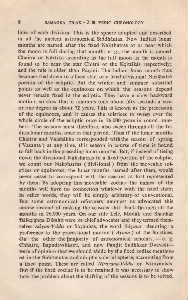Page 655 - Lokmanya Tilak Samagra (khand 2)
P. 655
8 SAMAGRA TILAK - 2 • VEDIC CHRONOLOGY
lines of each division. This is the sphere adopted and described
in all the ancient astronomical Siddhil.ntas. Now Indian lunar
months are named after the fixed Nak~hatras at or near which
the moon is full during that month; e. g., the month is named
Chaitra or Kartika according as the full moon in the month is
found to be near the star Chitra or the KrittikAs respectively;
and the rule is older than Pa~ini. The Indian lunar month thus
becomes tied down to a fixed star, or a fixed divisional Nak~hatra
portion of the ecliptic. But the winter and summer solstitial
points as well as the equinoxes on which the seasons depend
never remain fixed in the ecliptic. They have a slow backward
motion, so slow that it amounts only about fifty seconds a year
or one degree in about 72 years. This is known as the precession
of the equinoxes, and it causes the solstices to sweep over the
whole circle of the ecliptic once in 26,000 years in round num-
bers. The seasons must therefore, also sweep through all the In•
dian lunar months, once in that period. Thus if the lunar months
Chaitra and Vaishil.kha corresponded with the season of spring
( Vasanta ) at any time, this season in course of time is bound
to fall back in the preceding lunar months. But, if instead of tieing
down the divisional Nak~hatras to a fixed portion of the ecliptic,
we count our Nak~hatras ( divisional ) from the moveable sol-
stices or equinoxes, the lunar months, named after them, would
never cease to correspond with the seasons at first represented
by them. By adopting this moveable zodiac the names of the
months will have no connection whatever with the fixed stars;
in other words, they will be simply arbitrary or conventional.
But some astronomical reformers amongst us advocated this
course instead of making the seasons shift back through all the
,months in 26,000 years. On our side Lele, Modak and Shankar
"Balkri~h~a Dik~hit were its chief advocates and they termed them-
selves Sayan-·V adis or Sayanists, the word Sdyana denoting a
preference to the precessional motion ( Ayana ) of the Solstices.
On the other the lmajority of astronomical scholars, - e. g.
Chhatre, Bapudevsbastri, and now Pan!fit Sudbakar Dwivedi-
were of opinion that we should abide by the fixed zodiac mention.,
ed in the Siddbantas and adopt a siderial sphere, accounting from
a fixed point. These an! called Nirayana-Vadis or Nirayanists.
But if the fixed zodiac is to be retained it was necessary to show
how the problem about the shifting of the seasons is to be solved.

